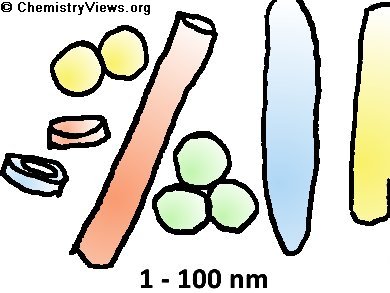Size and Shape of Nanoparticles
During the last couple of decades, chemists, materials scientists, physicists, and others have created and synthesized, etched and fabricated, a vast array of nanoparticle entities from the tiniest of spheres to long, gangly wires and myriad three-dimensional structures to boot. Critical to the application of specific nanoparticles in a technological setting is consistency of size, shape and form and, moreover, knowing precisely the composition of particles present in a sample.
Easy Detection
There are many disparate techniques for examining nanoparticles with some producing a wide range of results that, in turn, may require a wide range of skills for their interpretation. Writing in the journal Analytical Chemistry, Philip Wyatt of Wyatt Technology Corporation, Santa Barbara, California, USA, explains how classical multi-angle light scattering (MALS) measurements of monodisperse nanoparticle suspensions offer a relatively straightforward means of determining important elements of their size and structure.
A monodisperse sample is most easily achieved using liquid chromatography combined with field flow fractionation. Wyatt suggests that the Rayleigh-Gans (R-G) approximation for light scattering may be extended and simplified to address a variety of the different nanoparticle structures such as spheres (and aggregates thereof), rods, tubes, ellipsoids, rings, and super-ellipsoids. The light scattering properties of many of these structures depend critically upon their orientation with respect to an incident fine laser beam.
Traditional interpretations of the measured scattered intensities, and their variation with respect to the scattering angles detected, often relied on complex analyses for their interpretation. Wyatt suggests that all these calculations may not be needed if it is only a particular particle size element that that analyst seeks. He also points out that a new approach might also sidestep the need to apply the complex Lorenz-Mie theory to extract nanoparticles sizes and distributions.
Accuracy Sufficient for Quantitative Characterization
“The term nanoparticles has been chosen to characterize particles with one dimension or feature less than 100 nanometers,” says Wyatt. “A wide range of such particles, suspended in aqueous solutions, is well-characterized by the R-G approximation when applied suitably.” He has now developed the mathematics to simplify the extraction of information from light scattering data that greatly simplifies the interpretation given various assumptions about the suspension of nanoparticles being investigated. With further development, the work will allow the characterization of carbon nanotubes, cellulose rods, homogeneous spheres and other such nanoparticles.
The new approach, which begins from some elements of the Rayleigh-Gans theory of light scattering, should, Wyatt says, “permit the measurement of broad classes of particle shapes and sizes with accuracy sufficient for their quantitative characterization”.
- Measurement of Special Nanoparticle Structures by Light Scattering,
Philip J. Wyatt,
Anal. Chem. 2014.
DOI: 10.1021/ac500185w




